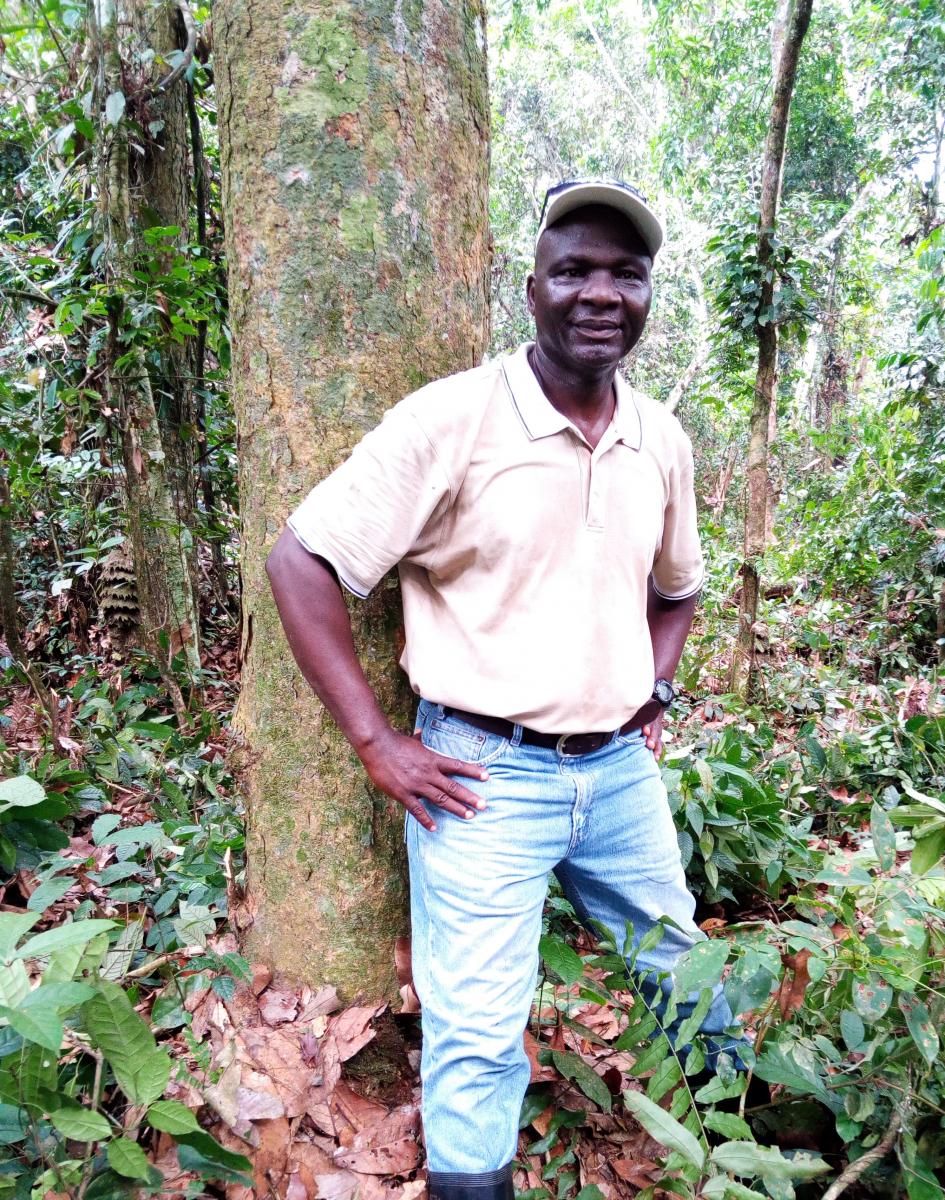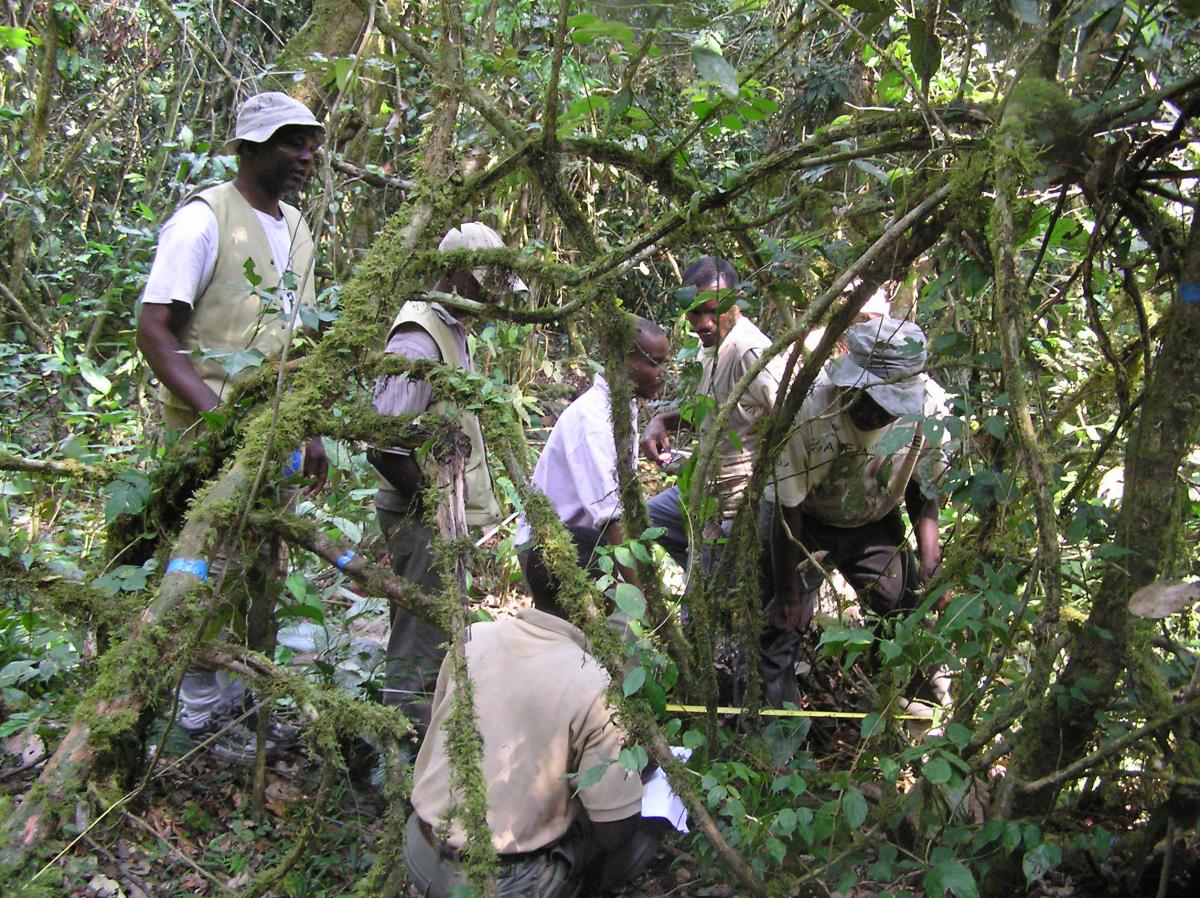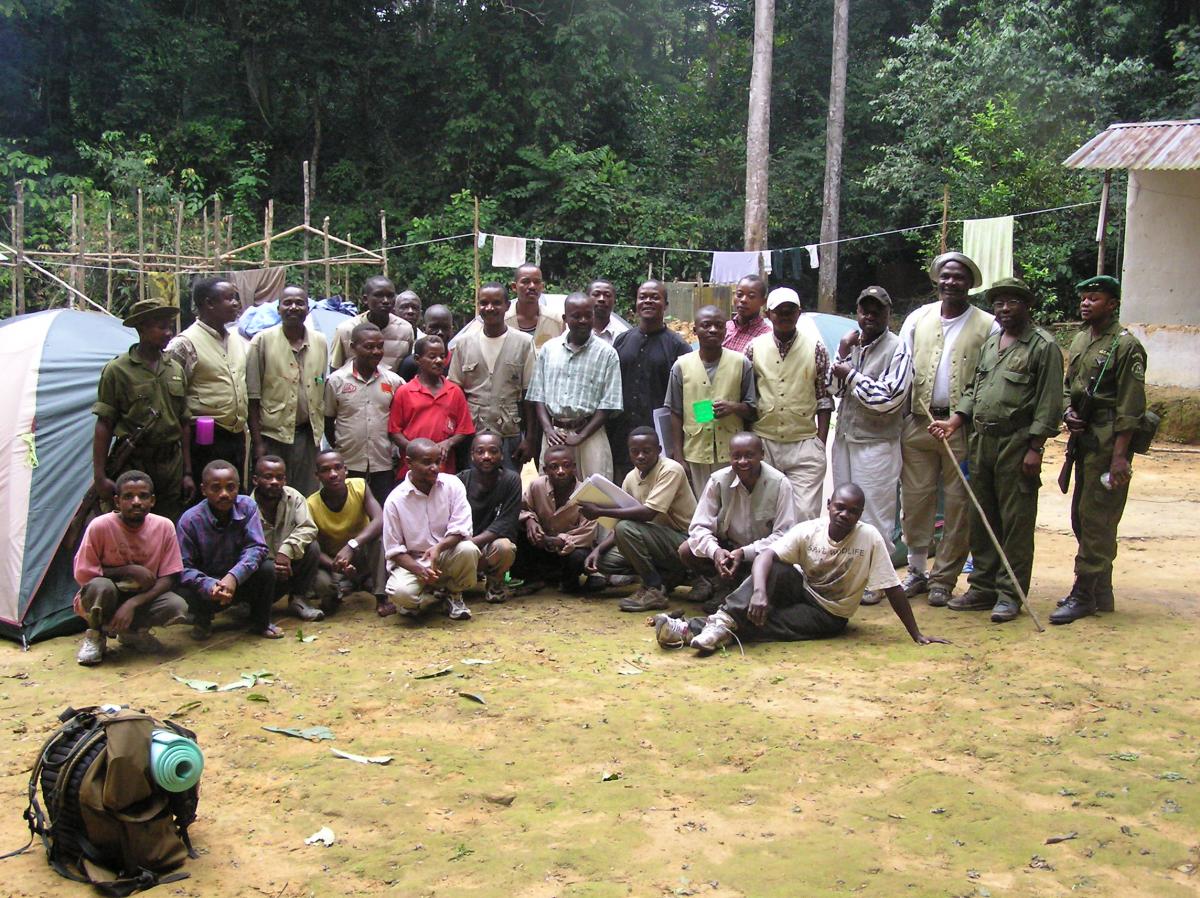Spotlight Series: Jean-Remy Makana & the Four Plots of the Ituri Forest
Jean-Remy Makana is a professor of forest ecology and conservation at the University of Kisangani (Democratic Republic of the Congo). His involvement with the ForestGEO network began when he oversaw with the establishment of the Ituri Plots (Did you know there are four?) in 1993. He is a PI of the Ituri Plots, a champion for the protection of forests and local livelihoods, and his current research focuses on the impacts of Gilbertiodendron dewevrei and its dominance on overall forest structure, floristic composition, and dynamics in the plots.
When did you realize you wanted to be a scientist/work in forest ecology? How did you decide to go down this career path?
Growing up in a rural area, I realized very early that I wanted to escape from that lifestyle and become someone important. First, I wanted to become a medical doctor, but very soon I disliked the idea of dealing with sick and sad people. So, my next plan was to be an agronomist in order learn more about farming and help my community whose main livelihood was farming. However, high school biology lessons captured my attention so much that I ended up enrolling in biology at the university, and because I still liked the idea of being an agronomist, I decided to study botany.
The more I learned about plants, forest ecosystems, and the threats that they were facing, the more my interest in contributing to the protection of forests and wildlife grew. Nearly everybody in my family and my community depended on forest resources. Saving the forest and its wildlife appeared to be the best way to contribute to securing the future for the people I cared about and loved. That’s what basically convinced me to become a forest scientist. In addition, nature is one of my first loves, and I take great pleasure being in the forest and observing its wonders.

What led you down the path to your current job? What has been your biggest challenge in getting to this point in your career?
Although I have held several positions, teaching has always been my favorite activity, perhaps because saving the forest will require the effort of a great number of people. As much as I wanted to improve my knowledge of forest ecosystems and approaches to protect them, I also wanted to share everything I was learning with as many people as possible. Teaching forest ecology and conservation courses was one of the best ways to achieve this goal.
The biggest challenge I was faced with in my quest to improve my knowledge of forest ecology was securing an opportunity to further my scientific education and increase my skills in forest research and conservation. It took me nearly ten years from the time I graduated from college to get an opportunity to start graduate school.
Can you describe your early involvement in the ForestGEO network?
In 1993 I was a teaching assistant at the University of Kisangani, when Drs Terese & John Hart came to the faculty looking for a research assistant to help with the establishment of the Ituri Forest Plots. The first task was choosing plot locations. Next was a plot survey, which I was in charge of. At the beginning of the tree enumeration process, I worked both as a cartographer (mapper) and botanist. Then, I led the field team for the first census from 1994 to 1996, before focusing on plot data management. My first direct contact with the Center for Tropical Forest Science (CTFS) [now ForestGEO] occurred in May 1995, when I participated in a CTFS conference organized in Washington, DC. The following year I received funding from the Smithsonian Tropical Research Institute (STRI) to participate in a short training on data management at the STRI headquarters in Panama City, near Barro Colorado Island. During the summer of 1998, I participated in another CTFS conference in Washington, DC where I presented the preliminary results from the initial census of the Ituri Forest Dynamics plots (IFDP). Then I attended nearly all CTFS analytical workshops until 2010, representing the IFDP and working on its dataset.
What is the most interesting or unique aspect of your site?
The Ituri Forest Dynamics Plots have many special features. The plots are located in a protected area, the Okapi Faunal Reserve, that is a UNESCO world heritage site because of its exceptionally high diversity of large mammals and cultural heritage related to the presence of indigenous people, the Mbuti and Efe Pygmies. Biogeographical evidence suggests that the Ituri forest was both an important Pleistocene forest refuge and a dispersal center for many of east and central African vertebrate taxa. The site is thought to be Africa’s most species-rich area in mammalian fauna. It harbors charismatic and/or threatened large mammals such as elephants, chimpanzees, okapis, buffaloes, as well as 17 species of primates and 14 species of forest antelopes (the latter of which are the main source of animal protein for local people).
The Ituri Forest Dynamics Plots are also known for containing a monodominant forest (where a single species dominates the canopy). Specifically, Gilbertiodendron dewevrei accounts for more than 70% of basal area of all trees greater than 1 cm dbh in monodominant forest stands. The Ituri monodominant forest contains some of the highest biomass density in the ForestGEO network, averaging roughly 500 Mg per hectare. Finally, instead of containing a single large plot, the IFDP are composed of four 10-ha plots, two in monodominant forest and two in mixed forest.

What questions are you currently addressing in your research/site?
Research at the IFDP is focused on the consequence of the dominance by Gilbertiodendron dewevrei on the overall structure and diversity of forests at the site. The dominance of this canopy species is associated with low stem density, high basal area and biomass, and low diversity of canopy trees. Current research is also investigating the dynamics of liana species, and initial results showed that, as a consequence of global warming, lianas are decreasing, instead of increasing, in abundance in the Ituri Forest Plots. We are also investigating whether the two monodominant forest stands are encroaching upon mixed forest areas.
What kind of capacity building opportunities does your site provide for students, early-career researchers, and the local community?
Tree enumeration and measurements of trees in the plots provide unique opportunities to students, early-career researchers, and community members to improve their knowledge of forest tree species and their expertise in forest inventories. Each plot census involves at least 30 people, including four botanists (team leaders), four mappers, tree climbers, and other crew members. Botanists and some mappers are university graduates, and a few of them have gone on to pursue graduate studies and become site PIs (Corneille Ewango) or work for international conservation organizations (Innocent Liengola and Peter Umunay). Among the people who participated in the Ituri Forest Plots work, three of them have received PhD degrees from western universities, two have master’s degrees, and many work with conservation organizations, the Congolese wildlife authority (park rangers), or the Ministry of the Environment. Congolese students use data from the Ituri plots for their final research projects.
We are working on creating a more robust partnership with the University of Kisangani to provide invaluable opportunities for students to receive training in plant identification, tree mensuration and data management, and analysis.

What is your favorite part about your work?
As a teacher, I enjoy contributing to the knowledge and skills of students and early-career researchers. Our work at the IFDP has substantially contributed to capacity building for many Congolese students and researchers, as well as members of local communities. Many of these trainees have engaged in scientific careers, some have become conservationists or environmental activists.
I also like spending time in the serenity of pristine forest, away from the busy and troubled city life. Those moments allow me to reflect on the greatness of nature and the meaning of life, especially human life.
Finally, I enjoy exploring data and revealing trends or information that cannot be noticed from visual examination of the forest. For example, liana abundance decreased in our mixed forests from 15,007 stems in 1995 to 9,978 in 2007.
What do you like to do when you’re not studying forest dynamics?
I joined the ForestGEO network when I was working as a teaching assistant at the University of Kisangani. Through the network connections, I was presented with the opportunity to pursue graduate school in the United States and Canada, where I received a PhD degree in 2004. So, besides my research work with the Ituri Forest Plots, I teach conservation and natural resources management courses at the University of Kisangani, and I also work with conservation or development organizations to build the capacities of state officials and community stakeholders in sustainable natural resource management.
I particularly enjoy working with local communities in community-based natural resource management projects aimed at reconciling biodiversity conservation and livelihoods objectives. This has brought me to the heart of the REDD+ process in the Democratic Republic of Congo, which has the dual objective of reducing deforestation and forest degradation while improving the livelihoods of local communities through sustainable agriculture and the development of alternative livelihood activities.
Web Presence: Ituri FDP | LinkedIn
Selected Publications
Glick, H.B., P.M. Umunay, J.-R. Makana, S.C. Thomas, J.D. Reuning-Scherer & T.G. Gregoire. 2021. Developmental dynamics of Gilbertiodendron dewevrei (Fabaceae) drive forest structure and biomass in the Eastern Congo Basin. Forests, 12, 738. https://doi.org/10.3390/f12060738
Ewango, C.E.N., F. Bongers, J.-R. Makana, L. Poorter & M.S.M. Sosef. 2015. Structure and composition of the liana assemblage of a mixed rain forest in the Congo Basin. Plant Ecology and Evolution, 148(1): 29-42. https://doi.org/10.5091/plecevo.2015.984
Makana, J.-R., CN Ewango, SM McMahon, SC Thomas, TB Hart & R Condit. 2011. Demography and biomass change in monodominant and mixed old-growth forest in the Congo. Journal of Tropical Ecology 27(5): 447-461. https://doi.org/10.1017/S0266467411000265
Makana, J.-R., T.B. Hart, D.E. Hibbs & R. Condit. 2004. Forest structure and diversity in the Ituri Forest Dynamics Plots. In: E. Losos and E. Leigh, Jr. (eds.) Tropical Forest Diversity and Dynamism: Findings from a Large-Scale Network, University of Chicago Press, Chicago, pp.159-174.
Makana, J.-R., T.B. Hart, C. Ewango, I. Liengola, J.A. Hart & R. Condit. 2004. Ituri Forest Dynamics Plots, DRC. In: E. Losos and E. Leigh, Jr. (eds.) Tropical Forest Diversity and Dynamism: Findings from a Large-Scale Network, University of Chicago Press, Chicago, pp. 492-505
